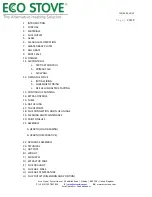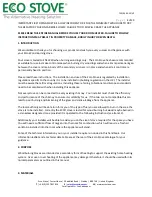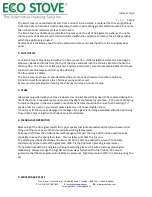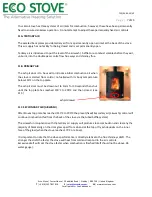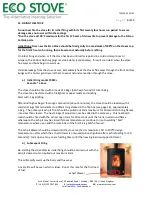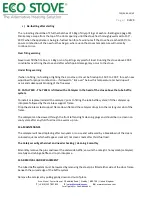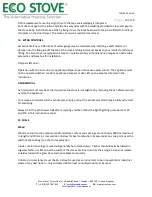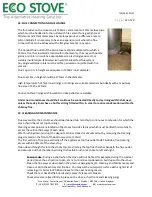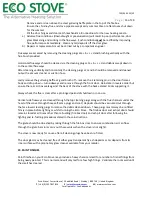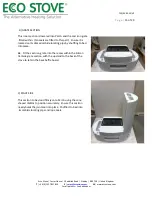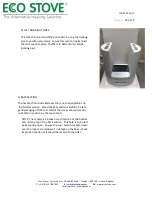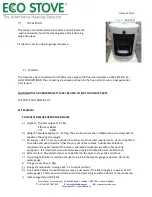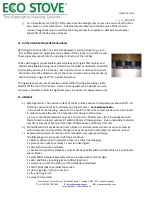
730/03.05.23/V2
P a g e |
5
of 29
Ecco Stove | Foster House | 2 Redditch Road | Studley | B80 7AX | United Kingdom
T
| +44 (0) 1527 857 814
E
W
| www.eccostove.com
For all patents
–
See Addendum
The Ecco Stove is constructed primarily from a mix of Silicon Carbide, a material that has a high affinity
to absorb heat but radiate it slowly and gently, therefore permeating greater distances within the home
than conventional materials of stove construction.
The Ecco Stove has double pass contraflow flue ways prior to exit of flue gasses to exhaust, to enable
the maximum of heat to be extracted and utilised within the appliance and hence the air space within
which the appliance is situated.
Radiant heat is emitted by heat from the external surfaces and initial heat from the front glass door
panel.
4. FLUE OUTLET
Your Ecco Stove is only delivered with a top flue connection. If the installation demands, a 45 degree
elbow can be taken directly from the top of the stove and back into the chimney Brest and hence the
chimney flue. The top or rear flue pipe must include a soot door / access plate within 200mm of stoves
top for stoves flue ways and chimney flue cleaning.
The flue outlet is 150mm
The Ecco Stove must have its own dedicated flue; it cannot be shared with another appliance.
Do not connect this appliance to a chimney serving another unit.
Access must be provided for cleaning the chimney and stove /connector pipe.
5. GLASS
Glass panel provided with your stove is deemed a consumable and may need to be replaced during the
life of the stove. Consumables are not covered by the manufacturers guarantee. In the event of having
to replace the glass in the stove please note that any fixtures should not be more than hand tight. If
captive nuts are used on your stove; please take care not to over tighten them.
Do not over fill the stove as damage or breakage of the glass is normally associated with the door being
closed onto a larger log than the firebox can accommodate.
6. CLEAR GLASS OPERATION
Blackening of the door glass results from poor quality fuel (unseasoned wood) and too slow an initial
firing until the stove has reached its optimum working temperature.
Chimney draft if less than 0.06 inches water gauge will impair the stove performance and hence its
capability to keep the door glass clean. Your installer will check this for you.
The whole stove body should be a minimum of 150 to 200
˚C
to enable the air wash to operate
satisfactorily on the inside of the glass face. (200
˚
C is the optimum operating temperature).
Do not load logs with the end grain pointing toward the glass as this will result in excessive glass
blackening. Always arrange the logs flat and crossways fashion within the firebox.
We cannot
guarantee that the stove glass will not blacken. However, high temperature (150
˚C
+) burning using the
sec
7. AIRATED BACK PLATE


